In modern homes, especially in urban environments where space is at a premium, combining the living room and dining area into a cohesive and functional space is a common challenge.
We will discover 25 creative layout ideas that maximize both function and style in small living room dining room combos. These ideas aim to inspire homeowners and apartment dwellers alike. They also provide practical solutions for everyday living.
1. Defining Areas with Rugs: A Detailed Approach

Utilizing area rugs to distinguish between the living and dining spaces is a subtle yet powerful way to organize a small living and dining combination room. The key is selecting rugs that complement each other in color, texture, and style, ensuring they harmonize with the overall decor.
For the living area, consider a plush, soft rug that invites relaxation and comfort. In contrast, the dining area can benefit from a flatter, more durable rug that can withstand chairs moving back and forth.
The placement of these rugs should create a natural flow between the two areas, subtly demarcating where one space ends and the other begins, without the need for physical barriers. This method not only enhances the visual appeal of the room but also adds a layer of practicality by defining functional zones within the shared space.
2. Floating Furniture Arrangement: Maximizing Space and Function

The concept of a floating furniture arrangement involves strategically positioning sofas, chairs, and tables away from walls, allowing them to ‘float’ within the space. This technique is particularly effective in a small living room dining room combo, as it facilitates a more flexible use of space.
By placing a sofa with its back towards the dining area, you create a natural division that feels intentional and inviting. This arrangement encourages a clear pathway around the furniture, making the room feel larger and more open.
Additionally, consider using slim-profile pieces and leaving adequate space between the back of the sofa and the dining area to maintain an uncluttered look. Incorporating floating shelves or wall-mounted lighting can further enhance the sense of openness, ensuring that the floor space remains as accessible as possible.
3. L-Shaped Couch as a Soft Divider: Creative Zoning
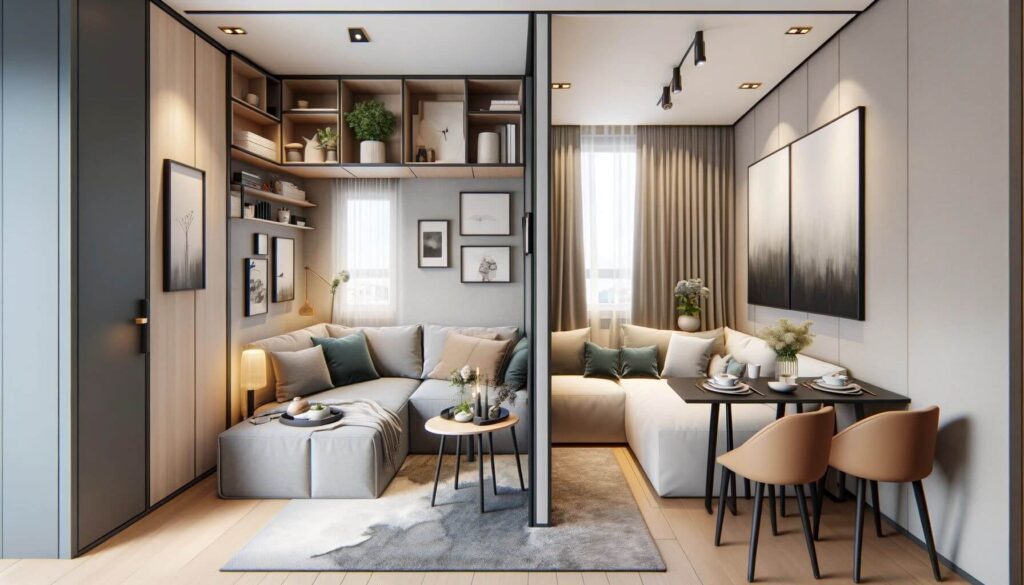
An L-shaped couch can serve as an excellent soft divider in a narrow living room dining room combo layout, offering a cozy and inviting seating area that naturally delineates the living space from the dining area.
The orientation of the L-shaped couch is crucial; it should be positioned to face the focal point of the living area, such as a television or fireplace, while the extension of the couch subtly separates the space without closing it off.
This small living room dining room combo layout idea encourages a seamless transition between the living and dining areas, fostering an environment conducive to social interaction and relaxation. To further define the space, consider adding a console table behind the couch, providing an additional surface for lighting, decor, or storage.
This setup not only maximizes the functionality of the space but also maintains a sense of openness and flow, crucial elements in the design of small combined spaces.
4. Round Dining Table for Better Flow: Strategic Choice

Choosing a round dining table for your small combo space is a strategic move for several reasons. Round tables eliminate sharp corners, making it easier to navigate around the room, a crucial feature in tight spaces. Additionally, round tables foster a more intimate dining experience, promoting conversation and engagement among all diners. When selecting your round table, consider one with a pedestal base to maximize legroom and chairs that can be fully tucked in to conserve space when not in use. This setup not only optimizes the flow and functionality of the dining area but also contributes to a more cohesive and inviting overall room design.
5. Multipurpose Furniture for Flexibility: A Smart Approach

In a small living room dining room combo, every piece of furniture should ideally serve more than one purpose. Ottomans that offer storage and seating, a coffee table that adjusts in height to become a dining table, or a sideboard that doubles as a media console are excellent examples. This approach not only saves space but also enhances the room’s adaptability to various activities, from daily living to entertaining. When shopping for multipurpose furniture, look for pieces that blend seamlessly with the style of both your living and dining areas, ensuring they contribute to a unified look that’s both stylish and functional.
6. Utilizing Vertical Space: Smart Storage Solutions

Maximizing vertical space with shelving, tall cabinets, or hanging elements can dramatically increase your storage capacity without sacrificing floor space. Consider wall-mounted shelves for books, decor, or even a vertical garden to add life and color to the room. Tall, narrow cabinets can store dining linens, serving ware, or media items, keeping clutter out of sight.
By directing the eye upwards, these vertical elements can also make the ceilings appear higher, contributing to a sense of spaciousness in the room. Ensure that the style and color of these storage solutions complement the overall decor, creating a cohesive and organized look.
7. Incorporating Mirrors: Enhancing Light and Space

Mirrors are a designer’s secret weapon in small spaces. A well-placed large mirror, or a series of smaller mirrors, can reflect both natural and artificial light, making the room appear brighter and more open. Consider positioning a mirror opposite a window to maximize the effect of natural light or above a console table to create a sense of depth.
Mirrors also add a decorative element, with frames that can complement the room’s aesthetic. This simple addition can transform the feel of the space, making it appear larger and more inviting without taking up valuable floor area.
8. Monochromatic Color Scheme: Unified Aesthetics
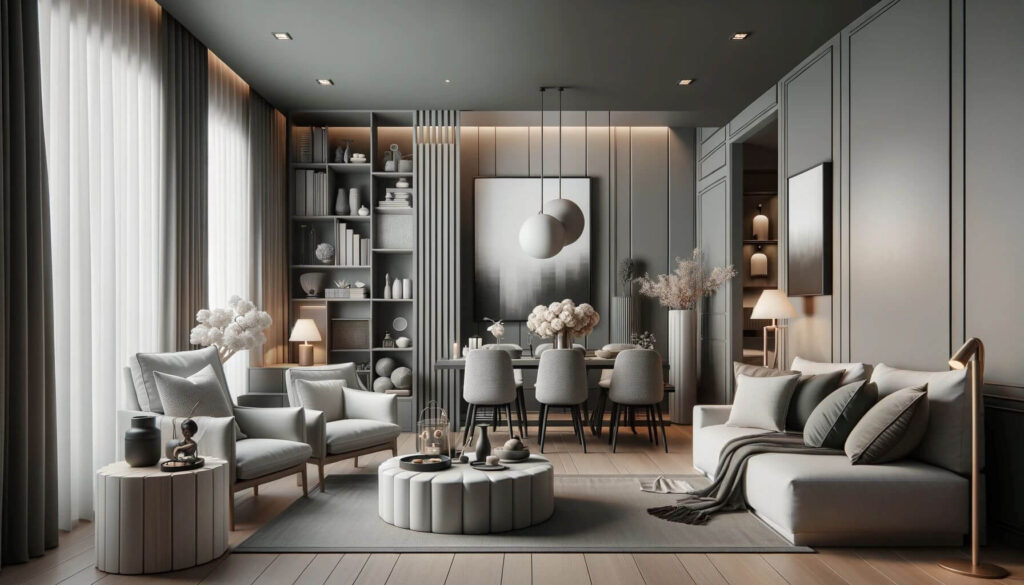
A monochromatic color scheme can unify the living and dining areas, creating a seamless flow between the two spaces. This doesn’t mean everything must be the same color, but rather variations of the same hue can add depth and interest.
For instance, soft grays can transition from light in the living area to a darker shade in the dining space, with textiles and decor pieces introducing texture and contrast. This cohesive color approach helps to visually expand the space, making a narrow living room dining room combo feel more open and cohesive. When implemented thoughtfully, a monochromatic scheme can also add a sophisticated touch to your combo room.
9. Contrasting Textures: Depth and Interest

In a small space, too many colors can feel overwhelming, but playing with textures can add the necessary depth and interest without cluttering the room visually. Combine soft upholstery with smooth wood finishes, plush rugs with sleek metal accents, and glossy surfaces with matte finishes.
These contrasts will draw the eye around the room, creating a dynamic and layered look that feels rich and inviting. When selecting textures, ensure they complement the room’s overall color scheme and contribute to the desired atmosphere, whether it’s cozy and warm or sleek and modern.
10. Flexible Separation with Sliding or Folding Doors: Adaptable Spaces
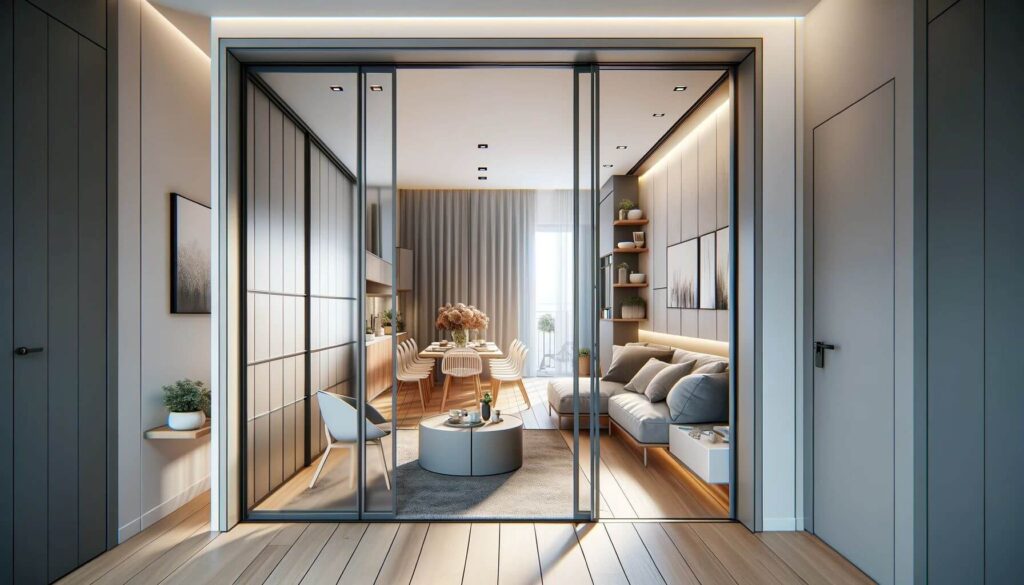
Sliding or folding doors offer a fantastic solution for separating the living and dining areas on demand. This flexibility allows you to open up the space for a grand, unified feel during gatherings or to close off the dining area for more intimate dinners or when requiring focus in the living area. These doors can be glass to keep the visual flow between spaces while closed, or solid materials for complete separation.
The choice of material and design can significantly affect the room’s aesthetics, so select doors that align with your overall decor theme. This very small living and dining room ideas introduce not only practicality in terms of space usage but also a significant design element that can become a focal point in the room.
11. Creating Lighting Zones: Atmospheric Division

In a small living room dining room combo, lighting plays a crucial role in defining and separating spaces without physical barriers. By establishing different lighting zones, you can subtly indicate the transition from one area to the next. For the living area, soft, warm lighting creates a cozy atmosphere, inviting relaxation and leisure. Floor lamps and table lamps can add layers of light, enhancing the ambiance.
Over the dining area, a statement pendant light or chandelier can serve as both a focal point and a source of functional, direct lighting for meals. Consider dimmable lights to adjust the mood for different occasions, further enhancing the versatility of the space. This strategic use of lighting not only differentiates the areas but also adds depth and character to the overall design.
12. Transparent Elements: Maximizing Visual Space
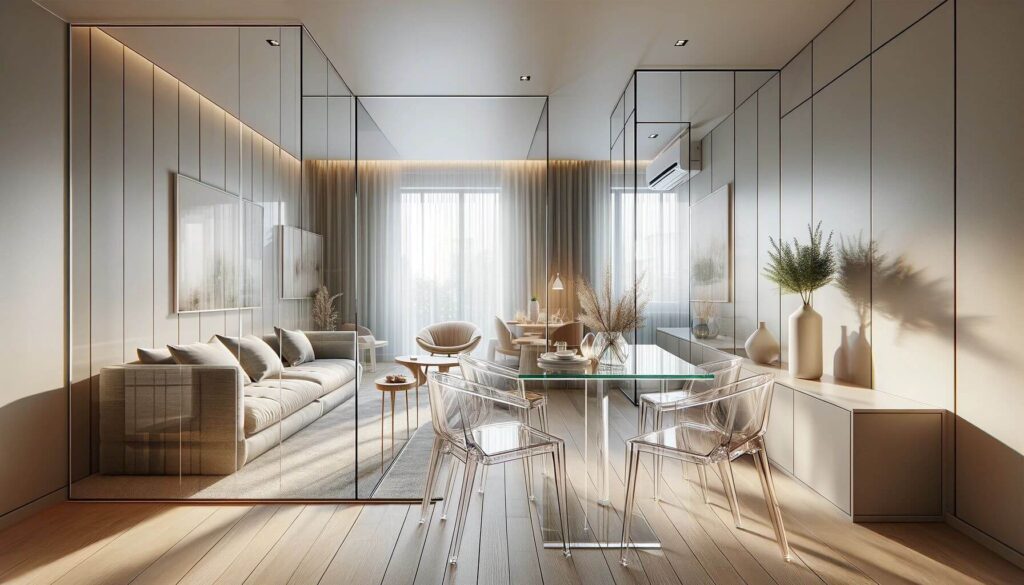
Incorporating transparent elements into your small living room dining room combo can significantly enhance the perception of space. Glass or acrylic furniture, such as coffee tables, dining chairs, or even decorative pieces, provide functional utility while minimizing visual clutter.
These materials allow light to pass through, maintaining an open, airy feel throughout the room. When selecting transparent items, consider their form and function within the space, ensuring they blend harmoniously with the other design elements while contributing to the illusion of a more expansive area.
13. Nested Tables for Versatility: Smart Surface Solutions

Nested tables offer an ingenious solution for small spaces, providing additional surface area when needed without permanently occupying valuable floor space. These tables can be pulled out for use as side tables, extra seating, or temporary dining surfaces, then neatly tucked away.
Opting for nested tables in materials and finishes that complement your overall design scheme ensures they enhance the room’s aesthetic while standing ready to serve multiple purposes. This flexible approach to furniture is particularly valuable in a combined living and dining area, where adaptability is key to maximizing the space’s utility and enjoyment.
14. Sofa Table as a Divider: Elegant and Functional
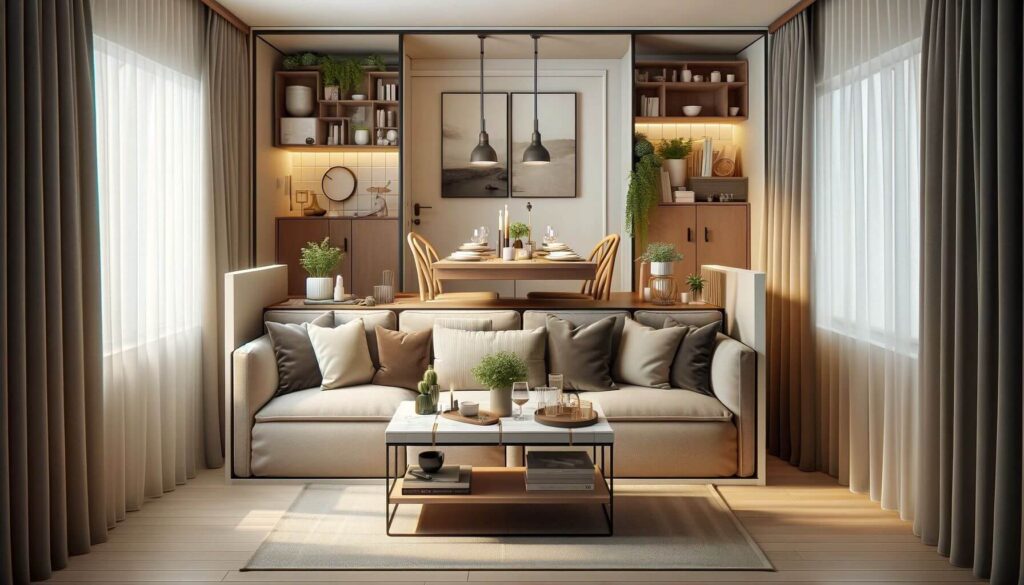
Placing a sofa table behind your couch can elegantly define the living area’s boundary while offering additional functionality. This piece of furniture provides an ideal spot for lamps, books, decorative items, or even dining accessories, bridging the gap between the living and dining spaces seamlessly.
When choosing a sofa table, consider its height in relation to the back of the sofa and select a style that complements your interior decor. This small living room dining room combo layout ideas not only enhances the room’s organization but also adds an extra layer of design, enriching the overall ambiance of the combo space.
15. Innovative Storage Solutions: Decluttering with Style
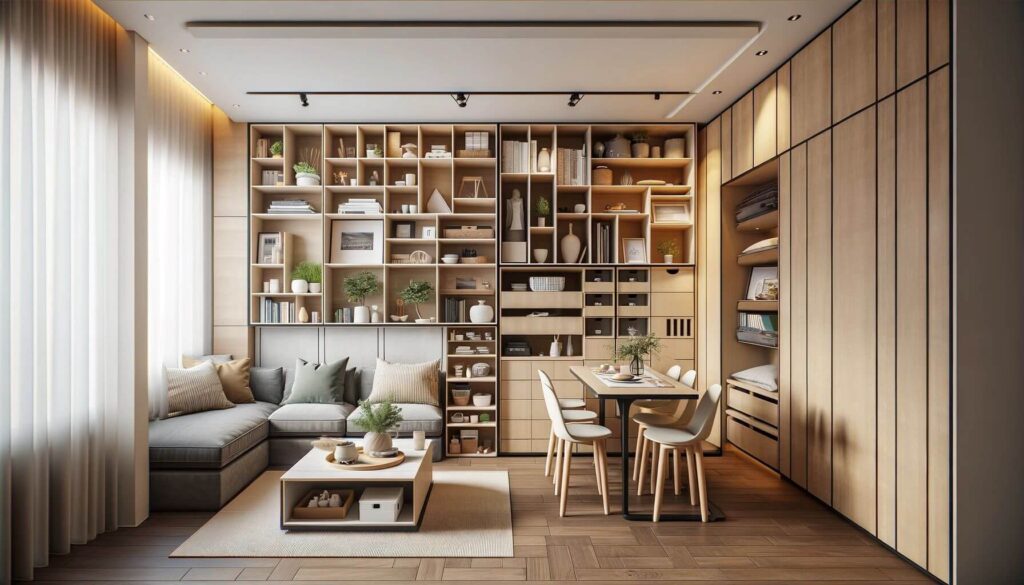
Effective storage solutions are essential in a small living room dining room combo to maintain a clutter-free and aesthetically pleasing environment. Built-in seating with hidden storage, open shelving units that double as room dividers, and tall, narrow cabinets are just a few ways to maximize storage without compromising style.
These options allow you to store away items when not in use, keeping the area tidy and spacious. When integrating storage into your layout, aim for solutions that blend seamlessly with the room’s design, ensuring functionality complements the aesthetic appeal.
16. Ceiling Treatments to Distinguish Areas: Visual Separation
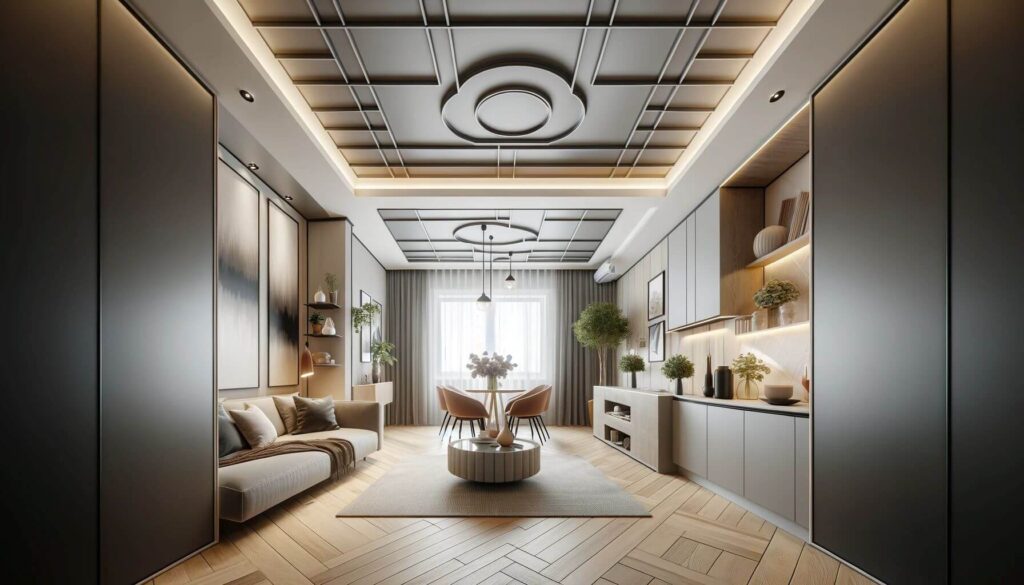
Applying different ceiling treatments above the living and dining areas can visually separate the spaces without the need for walls or dividers. This could involve distinct paint colors, wallpaper, or architectural elements like beams or moldings.
Such treatments draw the eye upward, creating a sense of division while maintaining the openness of the room. This approach not only adds visual interest to the ceiling but also helps to delineate the function of each area, contributing to a well-defined yet unified space.
17. Statement Lighting over the Dining Area: Anchoring the Space

A statement lighting fixture over the dining table serves a dual purpose: it provides essential task lighting and acts as a visual anchor for the dining area. This focal point can define the dining space within the larger room, drawing attention and adding a touch of elegance or personality, depending on the chosen style. When selecting your statement piece, consider the scale of the table and the overall room, ensuring the fixture complements the space without overwhelming it.
18. Symmetry for Balance and Harmony

Arranging furniture and decor symmetrically in a small living room dining room combo can create a sense of balance and harmony, making the space appear more organized and intentional. This approach can involve mirroring sofas, chairs, or decorative elements on either side of a central axis, such as a fireplace, window, or dining table.
Symmetry simplifies the visual clutter, leading to a more peaceful and aesthetically pleasing environment. It’s a powerful tool in design, particularly effective in spaces that serve multiple functions, as it brings a cohesive and unified look to the combined area.
By implementing these thoughtful and detailed layout ideas, you can transform your small living room dining room combo into a functional, stylish, and cohesive space.
Each strategy is designed to maximize both the utility and aesthetic appeal of the area, ensuring that it meets the needs of daily life while providing a welcoming environment for guests. Remember, the key to a successful combo space lies in the careful selection of furniture, decor, and layout choices that reflect your personal style and cater to your specific living requirements.
19. Embracing Minimalism: Less Is More

Adopting a minimalist approach in a small living room dining room combo can significantly impact the perception of space and tranquility. This design philosophy emphasizes the “less is more” mantra, focusing on the essentials to create a clean, uncluttered environment. Choose furniture with sleek, simple lines and keep decorative items to a minimum, selecting only those that have meaning or function.
A neutral color palette with occasional pops of color can add depth and interest without overwhelming the space. This approach not only makes the room appear larger but also facilitates ease of movement and maintenance, creating a peaceful and efficient living environment.
20. Adding an Accent Wall: Creating Depth and Focus

An accent wall can serve as a powerful design element in a small living room dining room combo, drawing the eye and adding depth to the space. Whether through paint, wallpaper, or textured finishes, an accent wall can demarcate the dining area from the living space, providing a backdrop that highlights the dining table or seating area.
Choose a color or pattern that complements the overall decor, ensuring it enhances the room’s cohesive feel. This focal point can add character and personal flair to your narrow living room dining room combo space, making it uniquely yours.
21. Incorporating Plants: Bringing Life to Spaces
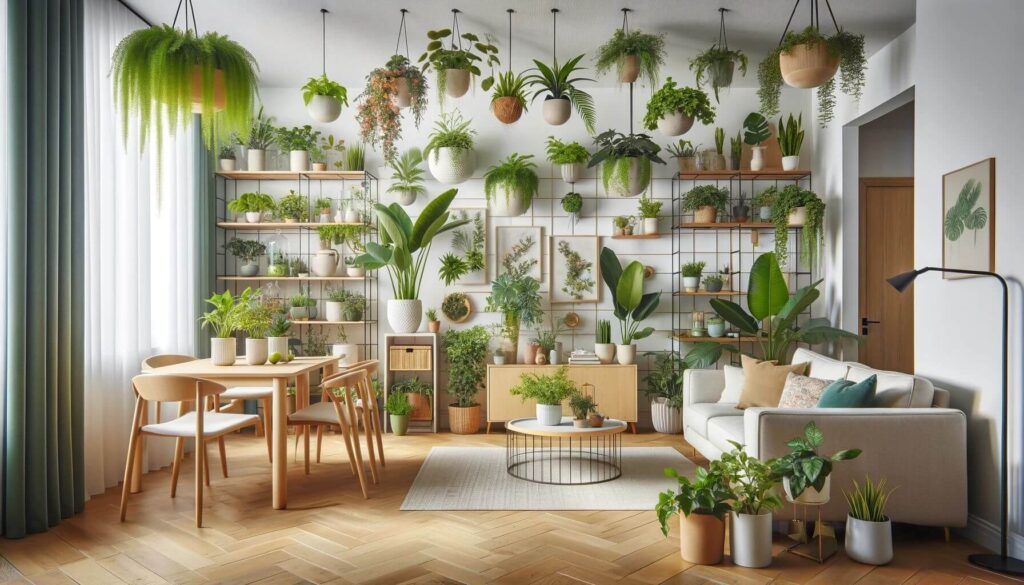
Plants are a wonderful addition to any dining and living room combo, adding vibrancy, color, and a sense of freshness. Besides their aesthetic appeal, plants can also help delineate spaces, with larger plants serving as natural dividers between living and dining areas.
They improve air quality and bring a touch of nature indoors, which can be soothing and uplifting. Choose varieties that thrive in your room’s lighting conditions and consider pot sizes and plant stands that complement your decor. Plants are not just decorative; they’re a living element that can enhance the wellbeing of your home environment.
22. Bar or Counter as a Transitional Element
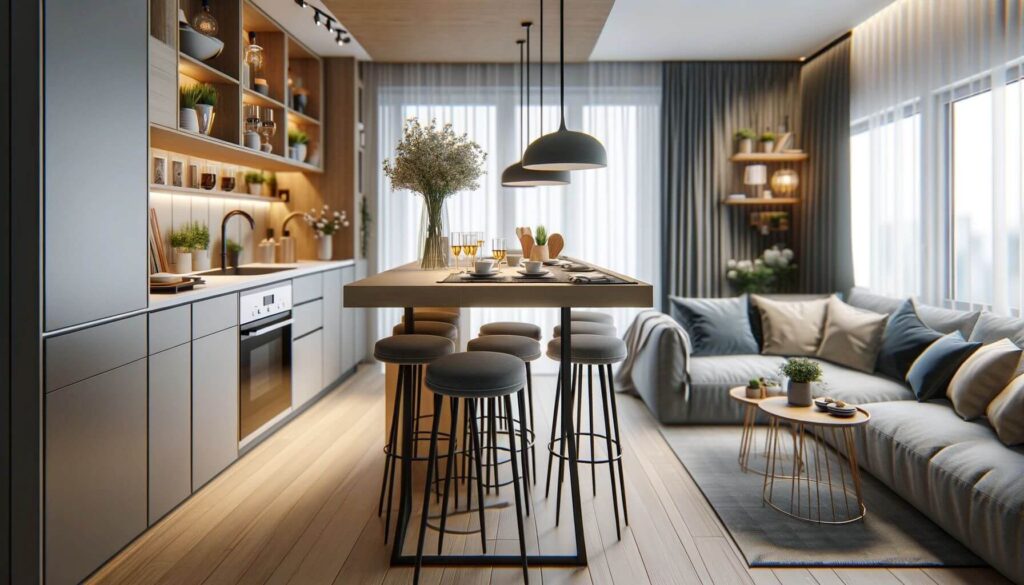
Adding a small bar or counter between the kitchen and dining area can offer additional seating and serve as a natural division in open-plan spaces. This element works especially well in a small living room dining room combo by providing a casual dining or working space that bridges the two areas.
It can also facilitate social interaction during meal preparation or entertain guests. Choose a design that matches your interior style, and consider stools that can be tucked away when not in use to maintain clear pathways.
23. Unified Window Treatments for Cohesion

Window treatments play a significant role in unifying a small living room dining room combo. Curtains, blinds, or shades selected in a style and color that complement both areas can help tie the space together, creating a seamless transition between living and dining zones.
Consider the functional needs of each area, such as privacy and light control, and select materials that address these requirements while enhancing the room’s aesthetic appeal. Consistent window treatments not only improve the space’s visual flow but also contribute to a harmonious and balanced design.
24. Personal Touches: Making the Space Your Own
Personalizing your small living room dining room combo is key to creating a space that reflects your unique style and preferences. Incorporate art pieces, family photos, heirlooms, or hand-picked decor that tells your story.
These personal touches should complement the room’s design, adding layers of meaning and interest. Display items in a way that does not clutter the space, using shelves, tables, or walls strategically. A space infused with personal elements is more inviting and comfortable, making it truly feel like home.
25. Flexible Seating Options: Adapting to Needs

In a small living room dining room combo, offering flexible seating options can maximize the space’s functionality and adaptability. Consider lightweight chairs that can be easily moved between areas, poufs, or ottomans that serve as both seating and storage, and a dining bench that tucks neatly under the table when not in use.
This flexibility allows the space to accommodate various activities, from quiet evenings at home to larger gatherings. Select seating that harmonizes with the room’s aesthetic, ensuring that even when pieces are moved, they contribute to a cohesive and inviting environment.
How To Arrange a Small Living Room And Dining Room Combo
Creating a small living room dining room combo that is both stylish and functional requires thoughtful planning and design. By incorporating these 25 small living room dining room combo layout ideas, you can maximize your space, ensuring it meets your needs while reflecting your personal style.
From strategic furniture placement and color schemes to personal touches and flexible seating, each element plays a role in crafting a cohesive, comfortable, and inviting space. Remember, the goal is to create a home that supports your lifestyle and brings joy to your daily living.
FAQ Small Living Room Dining Room Combo Layout Ideas
Q: How can I make a small living-dining room combo feel bigger?
A: Use light colors, mirrors, and transparent furniture to create the illusion of more space. Ensure good lighting and minimize clutter.
Q: What’s the best way to arrange furniture in a small living-dining combo?
A: Position furniture to define separate areas while maintaining a clear path for movement. Floating furniture and using rugs can help define spaces.
Q: Can I use bold colors in a small combined space?
A: Yes, but sparingly. Use bold colors as accents rather than primary colors to avoid overwhelming the space.
Q: How do I choose a dining table for a small combo room?
A: Opt for round or extendable tables that can be adjusted based on your needs and save space.
Q: Should the living and dining areas match exactly?
A: They don’t have to match exactly but should have cohesive elements, like similar color palettes or complementary styles, to unify the space.
Q: How can I add storage to my small living-dining room?
A: Use multifunctional furniture, vertical space, and hidden storage solutions like ottomans with storage or benches with under-seat compartments.
Q: Is it okay to mix different styles in a combo room?
A: Yes, mixing styles can add character. The key is to ensure there’s a cohesive element tying the different styles together.
Q: How important is lighting in a small living-dining room combo?
A: Very important. Use a mix of ambient, task, and accent lighting to create depth and enhance the functionality of each area.
Q: Can I still have a focal point in a small combo room?
A: Absolutely. A statement piece of art, a unique light fixture, or an accent wall can serve as a focal point without taking up space.
Q: How can I keep my small living-dining room combo from feeling cluttered?
A: Prioritize decluttering, choose furniture wisely, and ensure everything has a place. Regularly reassess your space to keep it organized and open.


Leave a Reply